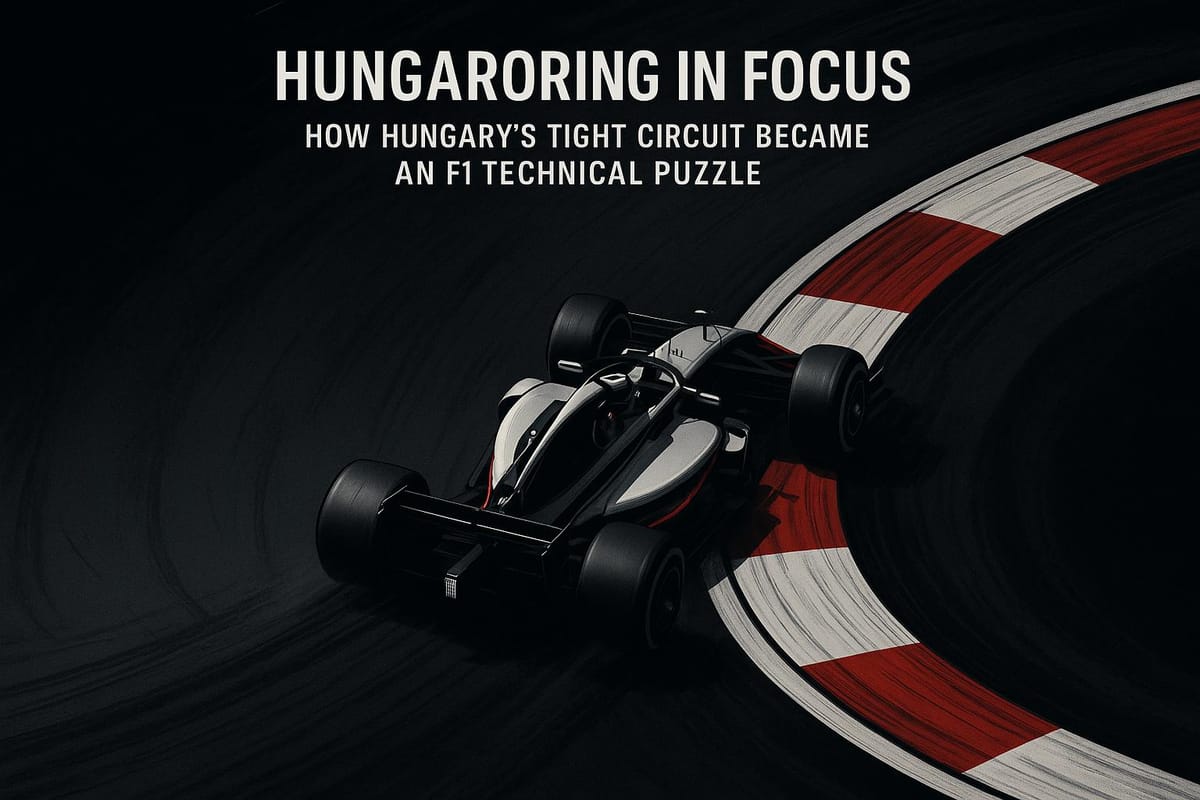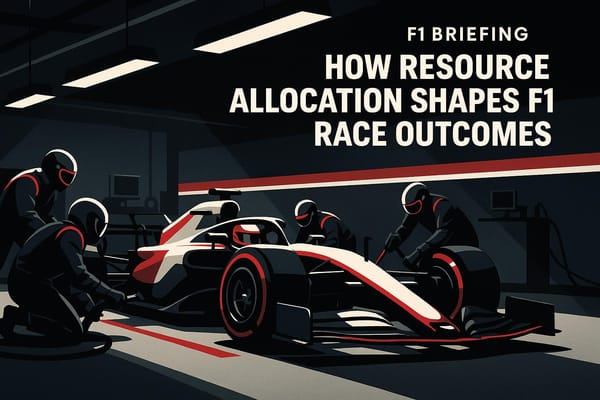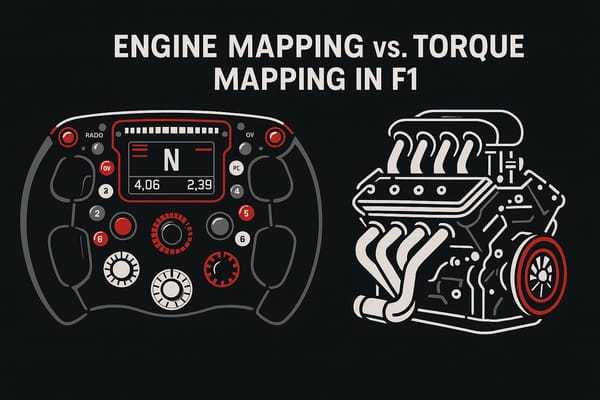Hungaroring in Focus: How Hungary’s Tight Circuit Became an F1 Technical Puzzle
Explore the unique challenges and technical intricacies of the Hungaroring, a key circuit in Formula One that tests precision and strategy.

The Hungaroring, located near Budapest, is one of Formula One's most challenging tracks. Known for its tight, twisty layout, it demands precision driving, technical expertise, and strategic brilliance. Here's what you need to know:
- Track Overview: Built in 1986, it's 2.722 miles (4.381 km) long with 14 corners, often called “Monaco without the barriers.”
- Unique Challenges: Minimal overtaking opportunities, constant cornering, and a slippery surface make it a test of skill and adaptability.
- Key Factors for Success:
- Downforce & Grip: High downforce setups are essential to navigate the relentless corners.
- Tire Management: Abrasive surface and high temperatures push tires to their limits.
- Qualifying Importance: Overtaking is tough, so grid position is critical.
- Weather Impact: Hot conditions and track evolution significantly affect car performance.
The Hungaroring rewards precision, strategy, and skill, making it a favorite among engineers and drivers alike. Its technical demands ensure it remains a cornerstone of the Formula One calendar.
Hungaroring Circuit Characteristics

The Hungaroring stands out on the Formula One calendar due to its compact and twisty design, presenting a unique set of challenges for both drivers and teams. Its layout demands a distinct approach, making it one of the most technically challenging circuits in the sport.
Track Layout and Dimensions
The Hungaroring’s layout is all about precision. With 14 tight corners, drivers face constant braking and careful acceleration throughout the lap. The longest flat-out section is just 2,979 feet (908 meters), meaning cars only hit full throttle about 50% of the time. Unlike circuits with long straights that encourage overtaking, this track’s corner-heavy design and multiple 180-degree turns leave little room for slipstreaming or passing.
Fernando Alonso summed up the challenge perfectly:
"You need to drive a bit like a rally driving style all through the lap. There is no time to breathe, it's corner after corner, it's like a small go-kart circuit for Formula 1."
Adding to its uniqueness, the Hungaroring is nestled in a natural bowl, creating an amphitheater-like atmosphere. This not only delivers excellent views for spectators but also adds to the intensity of the racing experience.
Track Surface and Weather Conditions
The circuit’s layout is only part of the challenge. The Hungarian Grand Prix is typically one of the hottest races on the calendar, with average air temperatures around 77°F (25°C) but often climbing to 91°F (33°C). Track surface temperatures can soar from 97°F (36°C) to a blistering 122°F (50°C) during peak sessions.
The track surface itself is built on sandy soil, which makes it dusty and slippery during early practice sessions. This abrasive surface, combined with the high number of corners, puts immense stress on the tires. Teams must carefully manage tire wear and grip, as the circuit's demanding layout can quickly degrade performance.
Pirelli’s Test Driver Lucas di Grassi highlighted the importance of tire precision here:
"The Hungaroring is a very technical track that will be well-suited to the super soft and soft tyres, and the key part is the second sector of the lap, which relies heavily on having proper downforce and a good rhythm. You have five or six corners in sequence, and getting every single one of them right is the key to a quick lap, so you need precision from the tyres."
The extreme heat not only accelerates tire degradation but also pushes car systems, especially brakes, to their limits. Frequent braking combined with limited cooling opportunities makes this track a true endurance test for both drivers and machines.
Track Evolution Effects on Performance
The Hungaroring’s tight design and abrasive surface mean the track evolves significantly over a race weekend. Early practice sessions often take place on a "green" track, with low grip due to a lack of rubber. As cars lap the circuit, rubber buildup improves traction, leading to noticeable lap time improvements by race day. Teams must continuously tweak their setups to match these changing conditions.
However, weather can throw a wrench into this process. Rain, for instance, can wash away the rubber buildup, resetting the track to a low-grip state. Additionally, fluctuating track temperatures play a big role in tire performance. While warmer conditions can help tires reach their optimal grip, excessive heat can lead to issues like graining and blistering. On the flip side, cooler sessions may prevent tires from reaching their ideal operating range.
Ultimately, the Hungaroring demands constant adaptability. Teams that can effectively respond to the track’s evolving conditions often find themselves with a crucial advantage come race day.
Technical and Race Challenges at the Hungaroring
The Hungaroring is notorious for testing every aspect of a car and driver. Its tight, twisty layout demands precision, with every component pushed to the limit under intense conditions.
Mechanical Grip and Downforce Requirements
The circuit’s layout calls for high levels of downforce to maximize grip through its constant turns. But achieving the right balance between aerodynamic downforce and mechanical grip is no easy task. For instance, during the 2024 Grand Prix, Ferrari's SF-24 struggled with rear-end instability in the second sector. To address this, the team stiffened both the front and rear anti-roll bars, which helped stabilize the car's underbody but came at the cost of early-corner grip. McLaren, on the other hand, found the sweet spot, achieving excellent front grip in critical corners by fine-tuning the balance between downforce and mechanical grip. Meanwhile, Mercedes' W15, with its front-end biased setup, struggled with the circuit’s rear-limited demands. These aerodynamic compromises also increase thermal stress on the tires, adding another layer of complexity.
Tire Management Demands
Managing tires at the Hungaroring goes beyond just dealing with wear. With cars spending only about 10 seconds per lap at full throttle, the relentless cornering and lack of cooling straights lead to overheating, which reduces grip. As Nico Hulkenberg put it:
"You're nearly always in a corner with no straights to cool the tires down."
Teams often lean toward a one-stop strategy to maintain track position, but this requires careful tire management over extended stints. The abrasive track surface and high lateral loads take a toll, particularly on the front tires. Jaime Alguersuari, Pirelli's test driver, emphasized the physical and technical demands:
"Hungary is a bit like a go-kart track: it's very good fun but a really tough race for the tyres and also the driver: your heart rate is at the highest that it is all year because of the high temperatures and not much cooling."
Qualifying Impact on Race Results
The Hungaroring’s narrow design makes overtaking a challenge, putting extra emphasis on qualifying performance. Securing a strong grid position can make or break a race. Despite this, no driver has won from pole since 2020, and the 2023 race featured just 51 overtakes. These stats highlight the importance of qualifying well. Teams prioritize single-lap performance during qualifying, even if it means sacrificing some aspects of their race setup. Engineers meticulously refine setups to shave off every fraction of a second, while drivers focus on smooth and precise inputs to maximize cornering speed and manage tire wear.
Car Setup for the Hungaroring
When it comes to the Hungaroring, cars are fine-tuned to prioritize downforce, making them cornering specialists. The unique demands of this circuit challenge teams to craft setups that balance technical precision with adaptability.
Suspension and Aerodynamic Adjustments
Aerodynamics take center stage at the Hungaroring, with teams opting for setups that generate maximum downforce. Aggressive wing settings are common - teams might use a balanced 36-36 configuration for races and push it to an extreme 50-50 for qualifying. The front wing is especially crucial here, ensuring the car remains stable and responsive through the circuit's many slow, twisty corners.
Suspension setups are equally critical. Unlike circuits that favor stiffer suspension for aerodynamic stability, the Hungaroring's sharp kerbs call for a softer overall configuration. This allows for smoother cornering without losing control, although a stiffer front suspension is often retained to maintain sharp steering response during the track's constant directional changes. Engineers also tweak the on-throttle differential, lowering its values to reduce wheelspin when exiting the circuit's slower corners. Together, these adjustments prepare the car for the physical and thermal demands of the track.
Managing Cooling and Brake Systems
The Hungaroring presents a tough challenge for cooling systems. High ambient temperatures combined with limited airflow opportunities can push brake discs beyond 1,000°C (1,832°F) during races. To combat this, teams must balance larger brake ducts for cooling with the aerodynamic drag they create. Drivers also play a role, using techniques like maneuvering behind safety cars to increase airflow or activating "Brake Warming" buttons during slower laps to maintain optimal brake temperatures. Despite these efforts, brake fade and the risk of fires remain constant threats, making cooling strategies a key part of race planning.
Recent Innovations in Setup Strategies
Teams have continued to refine their approach to the Hungaroring, leveraging advancements in car design. Modern Formula One cars generate more downforce than ever, enabling higher cornering speeds and setting the Hungaroring apart from its Monaco-like reputation.
Honda's former F1 technical director, Toyoharu Tanabe, underlined the circuit's unique challenges:
"It's a very different, much slower and technical type of circuit with just one short straight and many slow corners, making overtaking difficult so that qualifying position is very important. We are well used to it being very hot here and combined with the fact that car runs at relatively low speeds, it's a feature of this event that cooling is an important factor that we have to consider, when optimising our settings."
Red Bull driver Sergio Perez also highlighted the track's intricacies:
"The Hungaroring is a very unique track and it's very similar to Monaco with the high levels of downforce, it's a very technical track."
In response, teams now bring specialized aerodynamic upgrades tailored for maximum downforce circuits. These upgrades prioritize cornering performance over minimizing drag, a necessity given that eight of the track's 14 corners are taken at speeds under 93 mph (150 km/h). Additionally, tire pressure adjustments play a key role - lower pressures help maximize the contact patch for better traction while managing the heat stress caused by continuous cornering.
Hungaroring's Effect on Race Results and Driver Performance
The Hungaroring's distinct layout and technical challenges shape race dynamics and push drivers to their limits. Known for its tight corners and relentless pace, this circuit has consistently delivered unforgettable moments while demanding exceptional skill from those behind the wheel.
Driver Skills Needed for Hungaroring Success
The technical nature of the Hungaroring places a premium on driver ability. Precision is the name of the game here - every one of the 14 corners demands near-perfect execution. Unlike high-speed tracks where sheer power can sometimes mask small errors, even the slightest mistake at the Hungaroring can lead to noticeable time losses.
Patience is another crucial trait. With limited overtaking opportunities, drivers must bide their time and avoid forcing risky moves. This requires not only restraint but also the ability to stay mentally sharp under constant pressure.
The circuit's relentless demands also test a driver's reflexes and vision. Formula 1 drivers, on average, react nearly three times faster than the typical person, an ability that is indispensable on such a challenging track.
Former Renault driver Jolyon Palmer summed up the intricacies of the Hungaroring:
"Budapest feels like a small circuit when you're there but there's plenty that goes into it with 14 corners."
Beyond physical skills, the Hungaroring places a heavy emphasis on strategy. Success often hinges on executing complex tire management plans while maintaining strong track position, as raw speed alone rarely guarantees a good result here.
Memorable Races and Unexpected Results
The Hungaroring has a history of leveling the playing field, often producing surprising results that defy expectations. Its layout and strategic demands make it a track where skill and strategy can outshine outright car performance.
Take Jenson Button’s remarkable first win in 2006 as an example. A sudden rain shower turned the race on its head, and Button’s precise driving and patience allowed him to carve through the field and claim victory. Similarly, Damon Hill’s near-win in 1997 showcased how the track’s emphasis on driver talent can create unexpected opportunities. Hill’s incredible drive saw him leading late into the race, only for a mechanical issue to deny him a well-deserved victory.
These moments illustrate how the Hungaroring's unique demands can create thrilling races, where split-second decisions and driver skill often dictate the outcome.
Hungaroring's Championship Impact
The Hungaroring’s challenges don’t just affect individual races - they can shape entire championship campaigns. As MoneyGram Haas F1 Team Principal Ayao Komatsu explained:
"It's very, very difficult to overtake around the Hungaroring, so you put more emphasis on qualifying."
With overtaking at a premium, qualifying becomes even more critical. A single mistake during qualifying can have ripple effects, potentially derailing a championship bid. Additionally, the track’s strategic complexity forces teams to make high-stakes decisions during pit stops, which can make or break a title challenge.
Drivers and teams who excel in qualifying and adapt to the Hungaroring’s strategic demands often find themselves in stronger positions in the championship race. Combining flawless execution on Saturday with smart, flexible race-day strategies is key to thriving at this challenging circuit.
Conclusion: The Hungaroring's Continuing Technical Challenge
The Hungaroring stands as a persistent proving ground for Formula One teams, pushing the limits of engineering and strategy. Despite decades of aerodynamic progress, its tight, twisty layout continues to defy complete mastery, demanding a unique approach compared to high-speed circuits.
"Hungaroring is a pretty physical track in a current Formula 1 car, because there aren't any long straights and it's a very stop-start circuit, which means you are always working away at the wheel. And given the time of year, it's usually boiling hot, which definitely doesn't help."
The circuit's technical complexity has only grown as the sport evolves. The upcoming 2026 regulations, which will cut downforce by 30%, reduce drag by 55%, and introduce active aerodynamics with movable front and rear wings, promise to reshape strategies at the Hungaroring. These changes aim to open up new tactical approaches on a track where aerodynamic precision is critical.
Nikolas Tombazis, FIA Single Seater Technical Director, explained the intent behind these shifts:
"Lighter, more powerful and more focused on driver skill, the 2026 FIA Formula One Technical Regulations have been designed to provide closer racing among drivers, increase the competition between teams and to improve the spectacle."
This renewed focus on driver skill aligns perfectly with the Hungaroring's nature. The circuit rewards precision and consistency over sheer power, reflecting Formula One's evolving priorities. Teams now rely on cutting-edge computational tools to fine-tune aerodynamics and extract every ounce of performance.
As regulations push for tighter competition between teams, every decision - whether it's tire management on the abrasive track surface or optimizing mechanical grip through its demanding corners - becomes even more critical. Success here often translates into better preparedness for the challenges across the rest of the Formula One calendar.
Ultimately, the Hungaroring remains a quintessential test of Formula One strategy and skill. It exemplifies the delicate balance of engineering expertise, tactical planning, and driver ability required to excel in the sport. As technology and rules continue to evolve, this iconic Hungarian circuit will undoubtedly keep challenging the brightest minds and most talented drivers in Formula One.
FAQs
What makes the Hungaroring one of the toughest circuits in Formula One?
The Hungaroring stands out as one of Formula One's toughest circuits, thanks to its tight, winding layout and minimal straight sections. This design leaves little room for error, demanding drivers to showcase exceptional precision and control. The track is packed with slow, narrow corners - like the tricky Turns 6 and 7 - that challenge drivers to nail their braking and acceleration points perfectly. On top of that, overtaking here is notoriously tough, which means strong qualifying results and sharp race strategies are absolutely crucial.
Adding to the challenge is the circuit’s rolling terrain, which puts both car balance and driver stamina to the test. Teams face the intricate task of fine-tuning downforce, managing tire wear, and maximizing mechanical grip to handle the track's unique characteristics. Every lap becomes a complex puzzle, requiring both technical expertise and on-the-spot adaptability.
How do Formula 1 teams adapt their car setups for the challenges of the Hungaroring?
Formula 1 teams prepare for the Hungaroring by dialing in high downforce setups to tackle its tight and twisty design. This approach improves cornering accuracy and minimizes understeer, which is crucial for navigating the track's slow to medium-speed turns.
To achieve this, teams adjust the front wing angle for sharper turn-in and balance the rear wing to boost grip without compromising too much straight-line speed. Suspension settings are carefully refined, and the ride height is lowered to enhance both aerodynamic efficiency and mechanical grip. Managing tire pressures is another critical step, ensuring the cars handle well through the circuit’s demanding corners and brief straights.
These meticulous adjustments help drivers stay in control and push their cars to the limit on one of Formula 1's most technically demanding tracks.
How do F1 teams and drivers manage tire wear and performance at the Hungaroring, given its challenging surface and hot conditions?
F1 teams and drivers rely on a mix of tactics to tackle the Hungaroring's challenging surface and the intense summer heat. Drivers prioritize a smooth driving style, avoiding abrupt braking and sharp acceleration to limit tire wear. Meanwhile, teams carefully choose tire compounds and plan pit stops to strike the right balance between speed and durability over the course of the race.
Keeping tire temperatures in check is another key focus. Drivers manage this by applying throttle gently and modulating brakes with precision to avoid overheating, which can cause tires to wear out faster. Paired with customized car setups, these strategies allow teams to navigate the track’s tight and twisty layout while maintaining peak performance in tough conditions.




